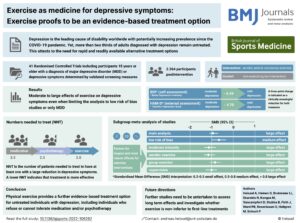In this blog, we explain the results of our review recently published in BJSM. We conducted a systematic review and meta-analysis of studies examining the effect of exercise interventions (including aerobic training like running and cycling and strength training) on adults with elevated levels of depression to synthesise existing evidence.
Why is this study important?
Depression is a prevalent and disabling disorder associated with reduced quality of life, medical comorbidity and mortality, and is a leading cause of disability worldwide. Increasing rates are highlighting the need for appropriate, accessible and cost-effective treatment options. It is important to know that about two thirds of adults with depression do not receive adequate treatment and that untreated depression often leads to intensification of the illness including the development of comorbidities resulting in even higher costs for society. This attests to the need for rapid and readily available alternative treatment options. Up to now, reviews have reported evidence for exercise but mixed results prevent us from recommending exercise as a full treatment alternative. This study is important since it is the largest and most current synthesis on the topic.
How did the study go about this?
We searched seven databases for studies that investigated exercise (defined as planned, structured, repetitive and purposive physical activity with the purpose to improve or maintain physical fitness) in treating depression in adults. There were 41 studies included in final analysis. We determined the effects reported in each study. Studies with more participants carried a greater weight. We also examined factors which could impact the effects reported and determined how much these factors affected the results.
What did the study find?
We found a large effect of exercise interventions in reducing depressive symptoms. Subgroup analyses revealed factors with the largest and most robust effects for exercise interventions:
- at moderate intensity that increases the heart rate and the body’s use of oxygen;
- that are supervised by trained exercise and health professionals;
- that perform aerobic exercise;
- performed within group settings.
We also found large effects for further regimens e.g., vigorous intensity and resistance training. For some regimens (like light intensity training) not enough studies could be included in analyses and therefore no statement could be made.
Including only studies with a low risk of bias (implying that results represent the true treatment effects) reveal moderate effects comparable to reviews investigating psychotherapy or medication. Further studies investigating long-term effects and if exercise is non-inferior to first-line treatments need to be undertaken.
Clinical implications included that if 100 people were each in the control and the exercise group, 20 participants in the control and 54 in the exercise group can be expected to have favourable outcomes. The numbers needed to treat (NNT) was 2 (low risk of bias 2.8) which is comparable to recent meta-analyses with psychotherapy revealing an NNT of 2.5 (low risk of bias 3.5) and for medication of 4.3. Based on an NNT of 2 for the main analyses this means that for every two people treated with exercise, it is expected at least one to have a large magnitude reduction in depressive symptoms.
Exercise showed an additional declining effect over control conditions of −4.70 points on the measure Hamilton Depression Scale (10 – 13 mild; 14-17 mild to moderate; >17 moderate to severe depression) in 16 studies and −6.49 in the Becks Depression Inventory (0–13 minimal, 14–19 mild, 20–28 moderate, and 29–63 severe) in eight studies. This indicates a clinically meaningful reduction of depressive symptoms from moderate to mild depression.
What are the key take-home points?
The results suggest exercise to qualify as an efficacious treatment option for depressive symptoms among people with depression focusing specifically on supervised and group exercise with moderate intensity and aerobic exercise regimes. This offers a further evidence-based treatment option for the large amount of untreated individuals, including those who refuse or cannot tolerate medication and/or psychotherapy or where they are not available. Given the high heterogeneity and mainly small and selected samples of the included studies, this requires individual decisions involving the treating physician to determine if and which conditions of exercise are the optimal treatment of choice while also recognising the potential synergistic effects of exercise in managing both physical and mental well-being. Therefore, clinicians, health practitioners and exercise professionals should consider exercise as an effective treatment option for depression in their practice.

Authors:
Dr. Andreas Heißel (Andreas.heissel@uni-potsdam.de)